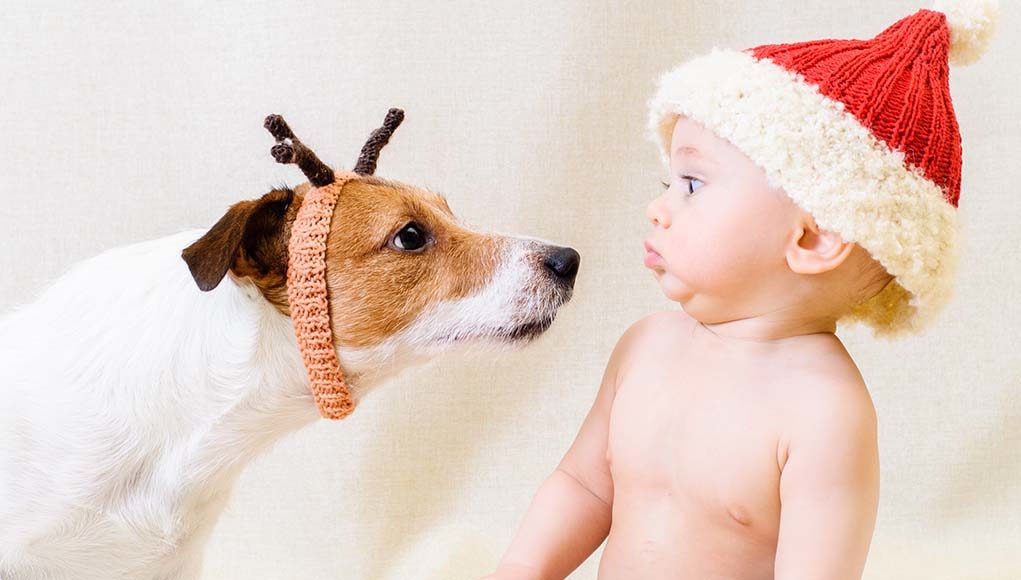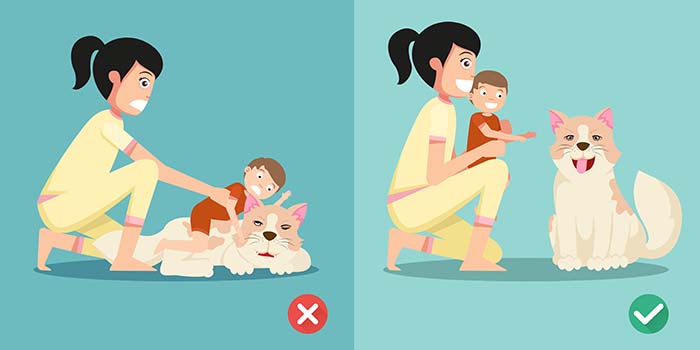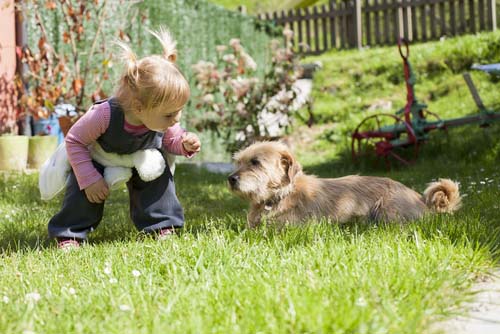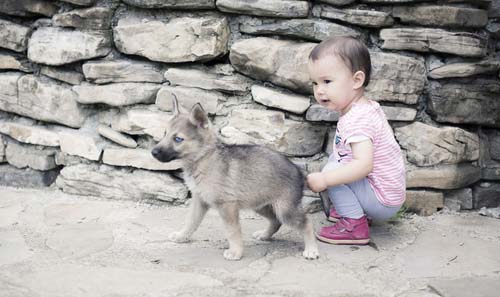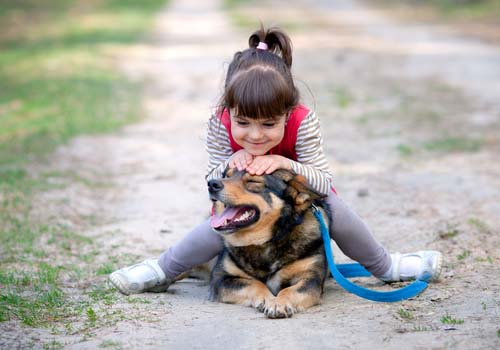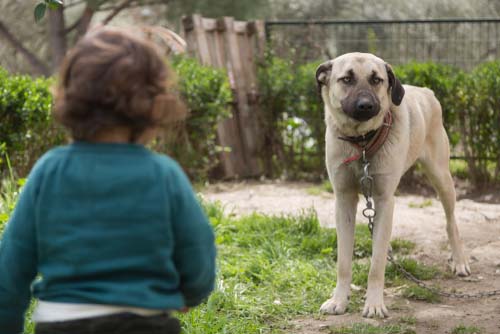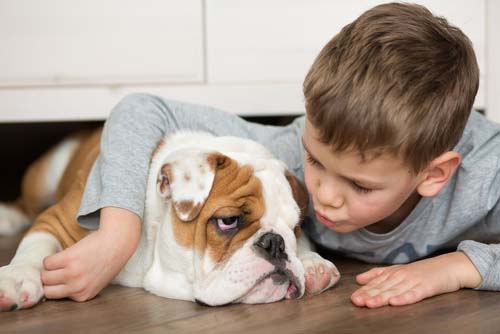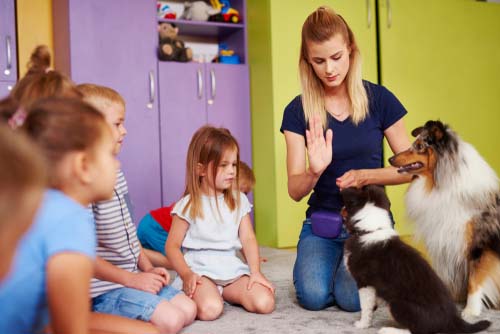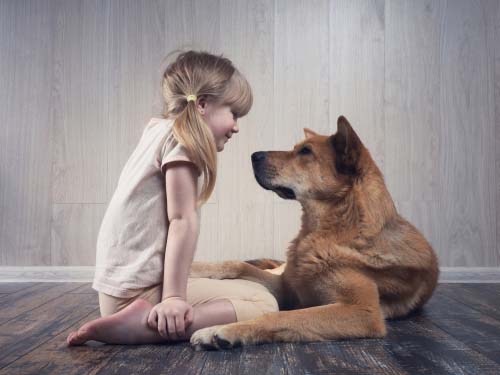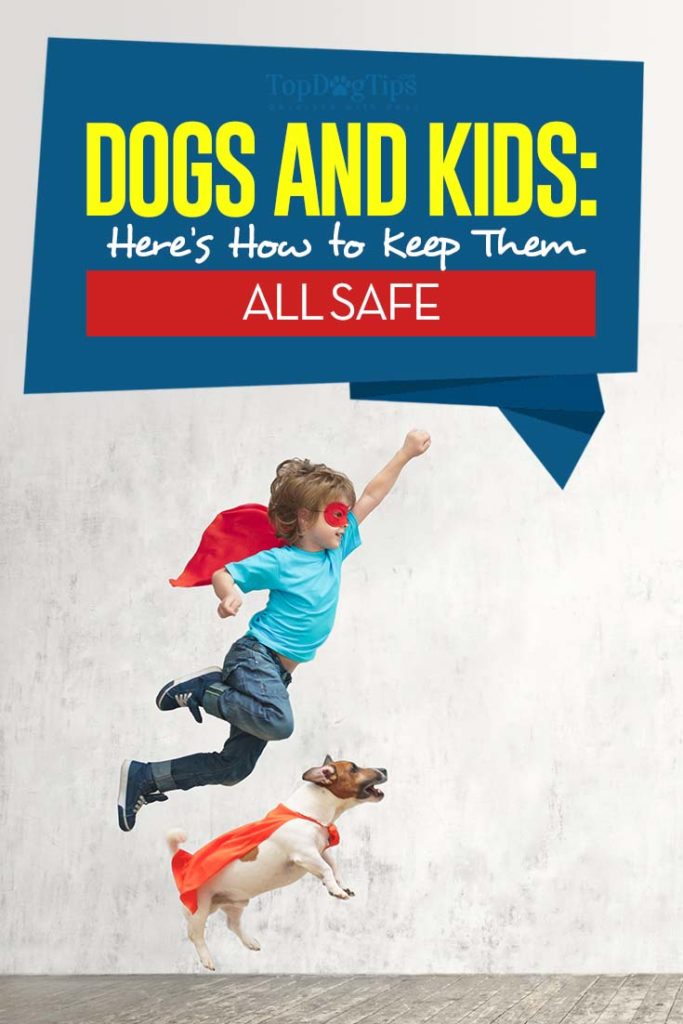Dogs can be unpredictable. Their social language is very different compared to humans, and this is important for pet owners with kids.
While some breeds are better with children than others, in a household with dogs and kids, some safety rules must be followed.
Table of Contents
- Dogs and Kids' Safety
- 17 Ways to Keep Kids and Dogs Safe
- 1. Asking Permission
- 2. Careful Approach
- 3. Always a Safe Distance Between Kids and Dogs
- 4. No Meal Interruptions
- 5. Children Must Respect the Dog
- 6. Sharing and Playing Between Dogs and Kids
- 7. Dogs Need Personal Space Away from Kids
- 8. Aggressive Dogs
- 9. Kids and Chained Dogs
- 10. Misleading Signs
- 11. Let Sleeping Dogs Lie
- 12. Rough Play
- 13. Hand-smelling
- 14. Security Precautions
- 15. Socializing Dogs with Kids
- 16. Avoid Stray Dogs
- 17. Body Language
- 18. No Loud Noises
- 19. Training Dogs with Positive Reinforcement
- Dogs and Kids: In Conclusion
Dogs and Kids' Safety
It's true that there are many benefits for young children growing up around dogs.
And in most cases, there will be no issues. However, that one single instance of a child pulling on a dog's ear (because they didn't know any better), and the dog reacting instinctively (also because they don't know any better) could change everything.
Recent studies observed that children are the number one victim of dog attacks, which makes our dogs the 2nd most dangerous animal in the United States.
The current rate of children fatalities is 4.6 in 10 million, and researchers observed how even this number could've been nearly zero because most cases are easily preventable.
There's a campaign called “Stop the 77“. The title is based on statistics that show how in the U.S., 77% of dog bites are from a pet dog that a kid knows.
Sometimes, this may have to do with a dog's natural aggression issues or lack of proper dog training, and other times it's because young kids haven't been taught how to behave around dogs and may overstep the line with an impatient animal.
If you're a current or future pet owner with young kids in the house, or you have children living in close proximity to dogs (e.g. next to dog parks, or in an area with many dog owners), to keep the kids and dogs safe, teach them about dog behavior and safety.
Below are 17 tips and “rules” to follow to ensure a safe and happy relationship.
17 Ways to Keep Kids and Dogs Safe
1. Asking Permission
Dog bites occur not only with family member dogs but also stranger dogs.
So when your kid approaches someone else's dog they don’t know, or one they don’t see very often, they should always ask the owner for permission if they can pet the animal.
No pet owner wants to see their dog hurt a child. If their canine is grouchy or sick, they will usually let you know.
Kids approaching stranger dogs without permission is a very common problem (especially in or near dog parks), and many parents, as well as dog owners, have complained about it in their shared stories.
2. Careful Approach
Recognition of facial and eye signals is built into most animals' psyche.
Different species react differently to body language and facial signals, but for dogs (and other canids like wolves), eye to eye contact means that someone is challenging them.
This is a way these animals establish dominance, and it will irritate the dog.
Experts have figured out the best way to come up to a dog to ensure everyone's safety: the person should always keep their eyes averted.
If it is a friendly dog, tell your kid to simply keep the gaze relaxed.
Your child can look at the dog’s feet, nose, etc. They should not maintain constant eye contact with the dog.
3. Always a Safe Distance Between Kids and Dogs
Canines do not like to have someone’s face in their face. Similar to the above, it's a sign of threat for the dog, and depending on the animal's temperament, the dog may simply turn away, or they may snap. Even most humans won't enjoy that kind of close contact.
When an interaction between kids and dogs happens, remind your child to keep some distance from the animal until it's clear that it's safe (such as with a long-time family pet).
Normally, you should not let your kid too close to strange dogs, or even talk loudly.
4. No Meal Interruptions
Dogs should never be approached when consuming food, and especially so at their food bowl.
This applies to anytime the dog is eating anything, whether it's a small treat or their regular dinner.
Some dogs are possessive about their food or chew bones.
They may see your child as a threat and will act by growling and may even bite, especially if they are a new dog.
Resource guarding is a common dog behavioral problem that needs fixing, but it's a good idea to make sure that all kids know this rule.
5. Children Must Respect the Dog
There are certain behavioral rules that kids need to know before they greet a dog and before you bring a newly adopted pet home.
A child will be a child, and sometimes kids do not understand the dos and don'ts of interacting with canines. This is one of the main reasons why dogs bite children.
For example, no one should ever pull a dog’s tail, pull their ears, or treat them like a rag doll.
Just like you would eventually get tired of it, so would a dog. When dogs are tired of something, they may bite.
Even the most patient animal have their limits, so as soon as you spot such behavior from your kid, you must discourage it even with a tolerant pet.
6. Sharing and Playing Between Dogs and Kids
Similar to food guarding above, some pets just don’t want to share anything.
If they have a toy, they may not want someone to come up and take it from them.
While a kid may simply wish to play, the dog might not see it that way.
Unless it is a long-time family pet that you know likes to play fetch, kids should wait for the dog to bring the toy to them, or have you set up the playground (with you supervising both kids and dogs at the same time).
As long as you are supervising, playtime with both your dog and your kid builds strong bonds between the two of them.
This will help the dog feel more comfortable with your children.
7. Dogs Need Personal Space Away from Kids
Pet dogs can get overwhelmed by the surroundings and seek out a place to rest.
When a dog goes to their bed, their crate, or under a bed, it means that they may be getting stressed or anxious, and are trying to find a spot they feel comfortable in.
Let your child know to respect the dog's choice to rest. Dog crates are often your pet's own space.
No one should ever chase after any canine trying to hide away, nor should they try to pull the dog out of the hiding place.
This will often lead to dog bites.
8. Aggressive Dogs
When dealing with potentially aggressive dogs on the street, kids need to know the rules of reading their faces and how to react.
When approached by a strange dog that is growling, the child must know to look down and to remain perfectly still.
A few more pointers: if a kid is on the ground, they must curl into a ball and remain still.
If they are standing up in front of a growling dog, they need to remain still with their arms down and look at their shoes.
This lets the dog know they do not need to fight for dominance. The child should never run; aggressive dogs will chase, catch and attack.
9. Kids and Chained Dogs
Dogs that are on chains or in cages will usually feel threatened by an approaching child.
They are in a position that they can’t get out of, and this can make them feel scared and incite fear aggression response.
Even though that's not always the case, sometimes dogs who are on chains at all times are also likely abused and mistreated, which makes them more aggressive.
Without exceptions, a child should never approach a dog that is tied up, chained up, or caged.
10. Misleading Signs
Contrary to popular belief, a wagging tail does not always mean a friendly dog. Data from studies show many different meanings for why dogs wag tails, but it's not what movies will let you believe.
Usually, when a pet dog wags their tail it means they are excited, but excitement can be good or bad.
They may have nervous excitement which means they are fearful and uncomfortable.
Even anger is an excited state that may lead to tail wagging on occasion.
11. Let Sleeping Dogs Lie
Similar to approaching a dog that's eating, under no circumstances should a child disturb a sleeping dog, too.
This can lead to a dog bite attack on the kid.
Imagine if you are in the middle of a good sleep and someone grabs you, yanks you out of bed.
A sleeping dog's feeling will not be much different to yours in this situation.
When the dog feels disorientated, they get scared and “fight or flight” response means there's a chance of a dog bite.
Teach a kid to never approach a dog that is sleeping, not only because the animal might attack but also because pets need their rest, too.
12. Rough Play
Kids need to know that they should never play aggressively with a dog.
If they start wrestling with the animal, pushing them, “play hitting” them, the canine may get confused and will then feel like they can play that way too.
This is just as important with a new puppy, and the so-called, “gentle giant” breeds.
Such playtime between kids and dogs leads to a dog biting or scratching unintentionally, or just getting fed up and biting a kid to make the playtime stop.
It's fine for dogs to play aggressively like this between themselves, but a child can easily get hurt in the process.
13. Hand-smelling
While people say hello by shaking hands or hugging, scientists say that a dog says hello by smelling others.
When it's safe to do so, children should always get down to the animal's level and then let the dog smell the child's hand before they touch the dog.
Teach your child what “when it's safe to do so” means in such cases. Then, teach them how to slowly hold out their hand, fingers, and palm pointing down (non-aggressive), and let the dog come up to them. The kid should not push their hand toward the dog.
14. Security Precautions
Because dogs are still unpredictable animals, as a pet owner it is your responsibility to make sure others in the household are safe, particularly when there are small children around. This includes all of your pets, too.
Depending on the situation, your kids and dogs may need to be kept separated.
When your pooch is outside, they may need to be in an outdoor pen. In the house, have a pet gate that locks so kids can’t get in without your permission.
No matter how friendly your dog is, always have
“Beware of Dog” signs so neighbors and their kids are informed.
15. Socializing Dogs with Kids
Teaching your dog how to behave around kids is just as important, and socialization is one of the most crucial aspects of dog training and ownership. Any pet owner must socialize with their dog without exceptions. This is for the safety of both the canine and those around.
Your pooch should have an opportunity to interact with strangers, other animals, and especially kids.
That way the dog is familiar, and not scared or insecure around “small humans.”
Always supervise such encounters so that you can help kids approach the dog when you are sure the animal is comfortable with it.
A great way to do this is to teach the kid about the importance of physical activity is to your dog by the three of you going on a walk and socializing the dog with the kid and other dogs together.
16. Avoid Stray Dogs
 Similar to approaching chained dogs, teach your children to absolutely never approach a strange dog on the street.
Similar to approaching chained dogs, teach your children to absolutely never approach a strange dog on the street.
These animals can be dangerous, so if they can spot a stray from far away, it's best to take a different route to avoid coming any closer.
Some pointers: if a kid finds a stray dog, they should back away slowly (using above tips) and inform an adult.
They shouldn’t run or scream.
This only attracts the attention of the canine. And they especially should not try to pet, feed or play with a stray dog.
17. Body Language
Just as you explain a dog's facial and eye recognition, teach your kids the basics of dog body language as well.
The most important one to know is an aggressive or annoyed dogs and an animal who are not interested in human contact.
For example, when a dog’s tail is between the legs, his ears are flat and back, and his mouth is tense and closed, this means they do not want to be played with.
A dog that is ready for some loving is relaxed, calm, and open, which is usually easy to tell.
18. No Loud Noises
Kids love to test their boundaries when playing and using their inside voices or slamming or throwing their toys.
Make sure you let your children know that loud noises like this can scare the dog and make them feel threatened if they decide to approach them.
They need to keep the loud noises to a minimum around a new pet or any dog.
19. Training Dogs with Positive Reinforcement
Having your child train your dog builds a wonderful relationship between them. If done improperly, it could hurt the relationship. At some point older children should do some training with the dog.
Make sure to teach them to give the dog lots of praise when training and rewarding them.
Giving the dog lots of attention and praise reinforces the respect the dog will have for whoever is training them.
This is also a great opportunity to work on a dog's inappropriate behavior.
The last thing you want is for the child to be abusive if they have a dog someday.
Teaching them how to train and work with dogs are positive learning experiences for both the dog and the kid.
Dogs and Kids: In Conclusion
By far, dogs can be one of the best companions, friends and guardians for a growing child. Many studies proven tons of benefits pets have on kids.
However, dogs are still animals and maintaining safety precautions, particularly for a small kid who can be easily harmed, remains the first priority for a parent-pet owner.
Raising kids and dogs require different skills on your part.
But if you, your small child and the rest of the family follow the above safety rules, it will drastically reduce chances of dog bite attacks and you having to relinquish your pet.
If you're thinking about adopting a dog, or having a child, there are resources and books out there that can help you better prepare for the change in your household and keep everyone, including kids and dogs, safe and happy.
READ NEXT:
- The Ultimate Guide for Raising Kids with Dogs
- If Your Children Aren’t Doing This, They Should Be!
- Dogs and Kids: 17 Rules to Keep Kids and Dogs Safe


